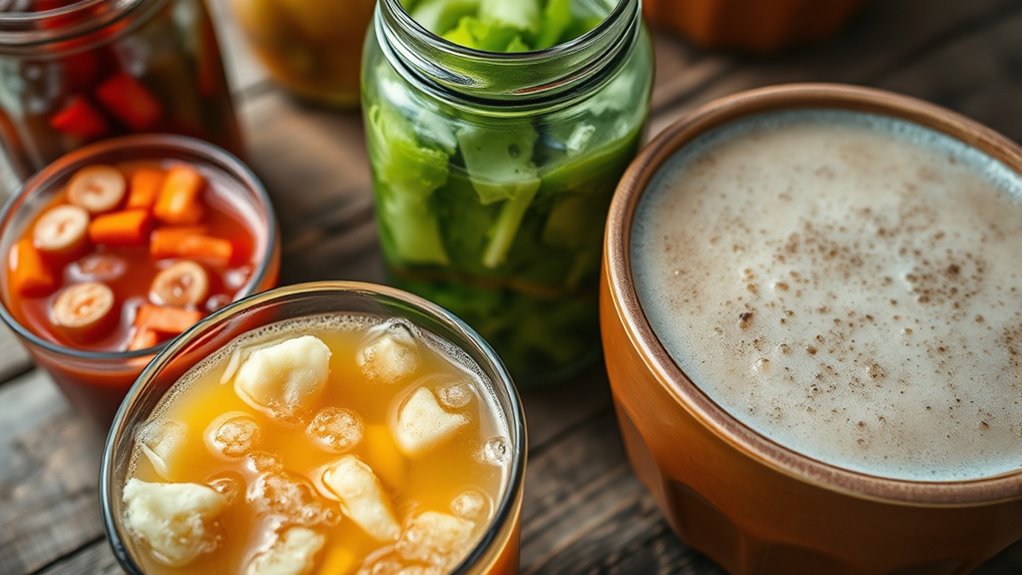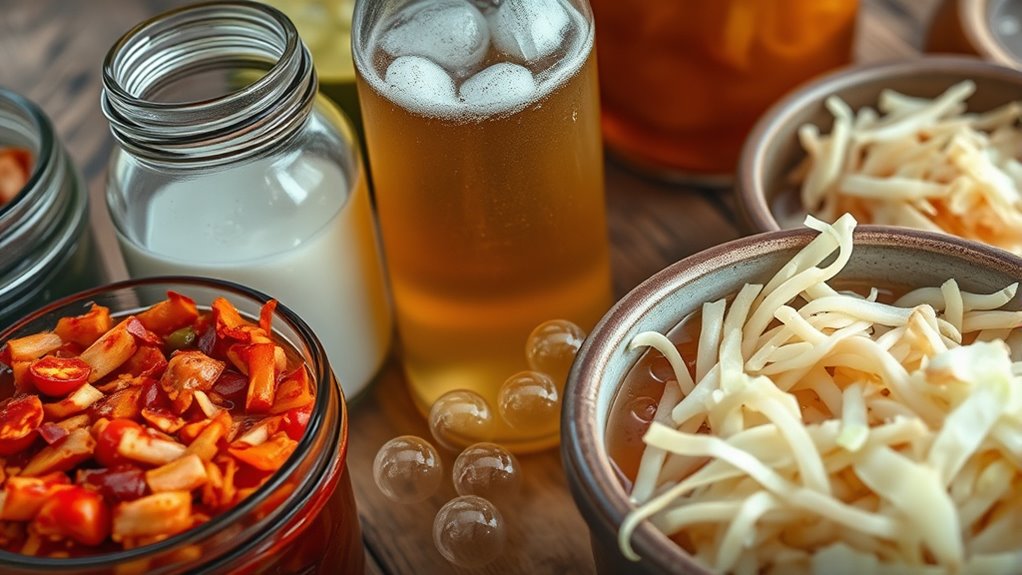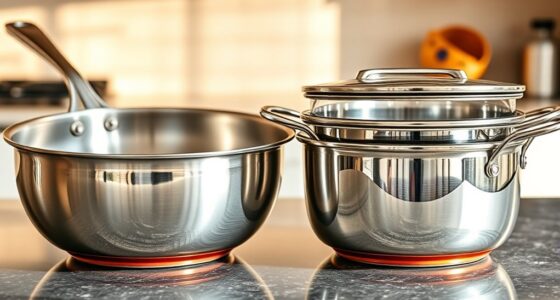Fermentation is a natural process where friendly microbes like beneficial bacteria break down sugars to create flavorful, probiotic-rich foods. By controlling factors like cleanliness, temperature, and salt, you can encourage these microbes to produce tangy flavors, preserve your foods, and boost their health benefits. When fermentation is done right, signs like bubbling and a sour aroma appear. Keep exploring, and you’ll discover more about harnessing microbes to transform your culinary creations.
Key Takeaways
- Fermentation is an anaerobic process where beneficial microbes convert sugars into flavors, probiotics, and preservation compounds.
- Beneficial bacteria produce tangy flavors, extend shelf life, and improve food digestibility and nutrient absorption.
- Proper fermentation requires hygiene, temperature control, and sometimes starter cultures for consistent results.
- Signs of successful fermentation include bubbling, sour aroma, and a tangy taste indicating active beneficial microbes.
- Mastering fermentation techniques allows for the creation of probiotic-rich foods like yogurt, sauerkraut, kimchi, and kefir.

Have you ever wondered how simple ingredients transform into flavorful, probiotic-rich foods? The secret lies in the fascinating process of fermentation, where beneficial bacteria work their magic. Fermentation techniques are ancient practices that harness these microbes to develop complex flavors and reveal health benefits. When you understand how beneficial bacteria operate during fermentation, you gain the ability to craft delicious, nutritious foods right in your own kitchen.
At its core, fermentation is an anaerobic process—meaning it occurs without oxygen—where beneficial bacteria feed on sugars and other carbohydrates. This microbial activity produces lactic acid, alcohol, gases, and other compounds, which not only preserve the food but also enhance its taste. For example, in making yogurt, lactic acid bacteria ferment milk, thickening it and giving it that tangy flavor. Similarly, sauerkraut ferments cabbage through specific fermentation techniques that encourage the growth of lactic acid bacteria, resulting in a crunchy, sour delicacy packed with probiotics.
Choosing the right fermentation techniques is vital to guarantee success and safety. Whether you’re fermenting vegetables, dairy, or grains, maintaining proper hygiene, controlling temperature, and selecting suitable starter cultures or relying on wild fermentation can influence the outcome. For beginners, using salt brines or starter cultures simplifies the process and promotes the growth of beneficial bacteria while inhibiting undesirable microbes. Temperature plays a key role too—most beneficial bacteria thrive around room temperature, so finding the ideal environment is essential for consistent results.
As you experiment with fermentation techniques, you’ll notice how the beneficial bacteria actively convert sugars into tangy flavors and probiotic-rich compounds. This microbial activity not only extends the shelf life of your foods but also enhances their digestibility and nutritional profile. Over time, you’ll learn to recognize signs of proper fermentation, like bubbling, sour aroma, and a tangy taste. These are indicators that the beneficial bacteria are doing their job, transforming basic ingredients into vibrant, health-boosting foods.
Understanding fermentation techniques and the role of beneficial bacteria empowers you to create a variety of fermented foods tailored to your palate. Whether it’s homemade kimchi, kefir, or fermented vegetables, mastering these methods allows you to enjoy the flavors and health benefits of traditional fermentation. With a bit of practice, you’ll find that fermentation is not only simple but also incredibly rewarding — a way to connect with age-old culinary traditions while nourishing your body with friendly microbes.
Frequently Asked Questions
Can Fermentation Be Safely Done at Home Without Special Equipment?
Yes, you can safely ferment at home without special equipment as long as you prioritize home safety and use basic equipment essentials like clean jars, fermentation weights, and breathable covers. Keep everything sanitized, monitor your ferment for mold or bad odors, and store it in a cool, dark place. Following these simple steps helps guarantee your fermentation process remains safe and successful, even without specialized tools.
How Long Does It Take to Ferment Different Foods?
Fermentation duration varies wildly, like a rollercoaster ride through time! For quick results, expect a few days for sauerkraut or yogurt, while longer foods like kimchi or sourdough bread may need weeks. The food’s type, temperature, and desired flavor influence aging time. Keep an eye on signs of fermentation, and remember, patience turns simple ingredients into complex, delicious creations!
Are There Common Mistakes That Ruin a Fermentation Batch?
You should watch out for common fermentation pitfalls that can ruin your batch. Poor sanitation can lead to microbial contamination, causing spoilage or off-flavors. Using incorrect salt levels or not submerging your ingredients properly can also hinder fermentation. Additionally, exposure to oxygen might promote unwanted bacteria. To avoid these mistakes, keep everything clean, follow trusted recipes, and make certain your ingredients are fully submerged and protected from air.
What Are the Health Benefits of Consuming Fermented Foods?
When you eat fermented foods, you boost your gut health by introducing beneficial microbes that aid digestion. These foods also support your immune system, helping your body fend off illnesses. Consuming fermented items like yogurt, sauerkraut, or kimchi can improve nutrient absorption and reduce inflammation. Incorporating them into your diet is an easy way to enhance overall well-being and strengthen your body’s natural defenses.
Can You Ferment Foods Without Using Salt or Other Preservatives?
You can try salt-free fermentation, but it’s more challenging since salt helps with natural preservation and controls unwanted bacteria. Without salt or preservatives, you’ll need to focus on maintaining a clean environment and controlling temperature to encourage friendly microbes. Using starter cultures or brine alternatives like whey can help. Although possible, salt-free fermentation demands extra care to ensure safety and successful fermentation.
Conclusion
Now that you’ve learned the basics of fermentation, you’re ready to explore these friendly microbes and create delicious flavors at home. Remember, patience and practice are key—just like the saying, “Good things take time.” Embrace the process, trust your instincts, and enjoy experimenting. With each batch, you’ll gain confidence and deepen your understanding of these tiny but powerful allies. Happy fermenting!









